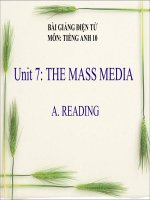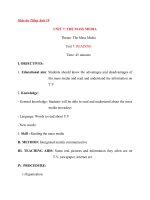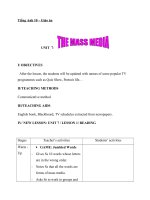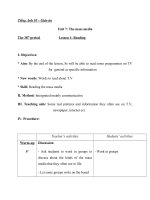Giáo án Tiếng Anh 10 Unit 7: The mass media
Bạn đang xem bản rút gọn của tài liệu. Xem và tải ngay bản đầy đủ của tài liệu tại đây (224.27 KB, 31 trang )
Giáo án Tiếng Anh 10
A - READING
I. OBJECTIVES:
1. Education aims:
- Students read about TV programme schedules.
2. Knowledge:
a. General knowledge: - Knowledge about TV programme schedules..
b. Language:
- The present simple tense.
- Vocabulary concerning TV programmes..
3. Skills: - Speaking : talk in pairs and in groups.
- Reading comprehension: Read for general ideas and specific
information.
II. METHOD: Integrated, mainly communicative
III. TEACHING AIDS: Real objects and pictures of TV programs.
IV. PROCEDURE:
Teacher’s Activities
1.Warm-up:( 3 mins)
Aims: sts get used to the topic.
+ Jumbled words.
Student’s Activities
- Give 5 words about the forms of mass - Work in groups of 3-4 sts
media whose letters are in the wrong
order and ask sts to work in groups of
3-4 sts to rearrange them in good order
- Sts write the words individually on the
blackboard
to make the right words.
1. television
4. magazine
1. enslieisov
2. rwepeapns
2. newspaper
5. video
3. idora
4. agenmzia
3. radio
5.evido
- 4 representatives are required to write
- Check and give remarks.
the words on the blackboard.
2. Before you read: ( 10 mins)
Aims: to prepare information and
- Listen to the teacher.
vocabularies for the topic.
+ Pairwork:
- Ask the sts to work in pairs to answer
- Work in pairs.
the question given in the part and some
other questions.
- For each question, 3-4 sts are required
- Do the work orally in front of the class.
to answer orally in front of the class ( 1
st/ 1 time).
- Gather the ideas and give some
background information about TV
channels in Vitetnam.
- Listen and copy down.
+ VTV1: Combination of Politics,
Economics and Entertainment.
+ VTV2: Science and Education.
- Read each word/phrase twice and ask
sts to repeat it and leave sts 1 minute to
self-practice.
- Provide the students with new
words/phrases
+ VTV3: Sports and Entertainment.
+ VTV4: For the overseas
Vietnamese.
+ VTV5: For the Ethnic minority
groups
Listen and copy down
+ Vocabulary:
+ channel (n)
: Kênh ( truyền hình)
+ Mass media (n): public institutions that
report news and other stories .
+ Population and Development (phr):
+ TV Series (n):
+ Folk Songs (n):
+ News Headlines (n):
+ Weather Forecast (n):
+ Quiz Show (n):
+ Portrait of Life (phr):
+ Documentary (n):
+ Wildlife World (n):
+ Around The World (phr):
- Listen and repeat.
- Some sts stand up and read these word
aloud.
- Ask 4-5 st to read all the
- Others listen.
word/phrases aloud in front of the class - Self-correct.
- Listen and help sts to read the
words/phrases correctly.
1. Task 1: Matching.
- Work in pairs to read the programmes
and do the task.
3. While you read:( 20 mins)
Aims: Read the passage for
information to do the tasks.
- Ask sts to read the TV programme
schedules and do task 1: Match the
words in A which appear in the reading
passage with their definitions in B.
- Sts are required to compare their results
with their partners.
- 4 sts are required to do the task orally in
front of the class (1 st/ 1 time).
- Share their answers with their friends.
- Some sts present their answes:
- Listens and helps sts to do the task
Suggested answers:
correctly.
1 – c; 2 – a; 3 – d; 4 – b
Gives feedback and corrects the
+ Task 2: True or false:
answers
- Sts read the programmes carefully,
T: Read the passage again and decide individually and decide whether the
whether the statements are true or statements are true (T) or false (F).
false as well as correct the false.
- 5 sts are required to give their answers
Teacher has the class read the text orally, individually in front of the class
again, this time more slowly, to scan with the evidence in the reading passage.
the details and do the task.
- Listen and check the answers orally in
1. Teacher walks around the class and front of the class.
offers ideas and comments when
students need help. Then teacher
The answers:
selects some students at random to 1. T
2. T
provide the answers in front of the 3. F ( The Nature of Language is on
class.
VTV3.)
4. T
5. F (VTV1 starts at 5:35 and the last
programme starts at 23:30
- Others listen and check.
+ Task 3: Answering questions.
- Work in pairs.
- Some pairs stand up and ask and
answer:
- Ask sts to work in pairs and answer
The answers:
the questions in the book basing on the
1. There are five films on.
information in the reading passage.
2. At 9:00 a.m, 12:00 at noon, 7:00p.m,
- 6 pairs are required to answer orally
11:00p.m on VTV1 and 7:00p.m on
in front of the class ( 1 pair/ 1 time).
VTV3.
- Listen and help sts to answer the
question correctly.
3. VTV2
4. The Quiz Show.
5. (You should watch) VTV1
6. Football
- Work in pairs.
- Some sts talk in front of the whole
class.
4. After you read:( 10 mins)
- Others listen.
Aims: to give the summary of the topic.
- Listen and self-correct.
- Sts are required to work in pairs to
Suggested answers:
tell their partners about one of the TV
programmes they like watching best
and explain why.
- 2-3 sts are required to give short talks
on the given topic.
What TV program do you like best?
I like the show The price is right most
because it is easy to play and very
interesting. Besides, the reward for the
winner is valuable,
- Get feedback and help the students to
give correct talks
5. Homework:( 2 mins)
- Write a paragraph about a programme
you like best.
- Prepare for the next lesson: SPEAKING
V. EXPERIENCE:
B- SPEAKING:
I. OBJECTIVES
1. Education aims: - Students know about the differences and similarities of
some popular types of the mass media.
2. Knowledge:
a. General knowledge: - Students can talk about the different types of the
mass media.
b. Language:
- The simple present
- Vocabulary on the mass media.
3. Skills: - Speaking about different types of the mass media.
- Discussing about the features the types of the mass media have in
common and the main features each of them has.
II. METHOD: Integrated, mainly communicative
III.TEACHING AIDS: Pictures, textbook, cassette player.
IV.PROCEDURE:
Teacher’s Activities
Student’s Activities
1. Homework checking(5
mins)
- One student talk about the TV programme
- Ask one st. to talk about the they like best.
TV
programme
they
like
Eg: I like Game show The price is right
watching best.
most because it is very interesting , easy to
play . Besides , the reward for the winner is
valuable . Another reason I like this game
show is the MC. Mr. Luu Minh Vu is
humorous and very intelligent .
+ Task 1:
- Write the new words and read them aloud.
Aims: Sts distinguish the different types of the
mass media from the others.
2. Before you speak(5 mins)
+ 'orally ( adv ) : spoken by mouth
- Introduce some new words:
+ 'aurally ( adv ) : seen by eyes
- Ask sts to read the new words
+ 'visually ( adv ): heard by ears
orally.
- Ask sts to work in pairs and - Work in pairs
decide which items are types of
the mass media.
- Listen and take notes.
- Ask sts about the definition of
the mass media:
Mass media ( take a singular
or plural verb) : communication
- Some sts give their answer in front of the
class.
media in general- all of the Suggested answers:
communication
reach
a
media
large
that
audience,
especially television, radio and
1. Television
newspapers.
2. Radio
- Call on some sts to explain
3. Newspapers
their answers in front of the
class.
4. The Internet
+ Task 2:
- Give sts correct answers.
- Work in pairs to discuss some popular types
of the mass media.
- Some sts give the answers in front of the
3. While you speak( 18 mins)
class.
Aims: Sts compare the features + The mass media:
of the types of the mass media.
- Ask sts to work in pairs and
carry out the activity using the
- Provide information and entertainment
+ The radio:
- Present information and entertainment orally
cues in the book.
- Go around the class and help
(through mouth)
- Receive information aurally(through ears)
sts if necessary.
.................................
- Call on some pairs to explain
their answer in front of the class. eg. The common feature of the mass media is
that
- Ask sts to look at the
information
above
and
talk
they
all
provide
information
and
entertainment.
Television provides information and
about the different types of mass entertainment orally and visually, and we
receive them through our eyes and ears.
media.
.........................................
4.
After
you
speak(
15 + Task 3:
minutes)
Aims:
- Work in groups to answer the questions in the
Talking
about
the book.
different types of the mass
media.
S1: Television, radio, newspapers, the
Internet.
- Ask sts to work in groups and
answer the following questions:
+What are the different types
of the mass media?
S2:
Provide/
deliver
information
and
entertainment.
S3: TV presents information and entertainment
orally and visually while radio provides ...........
- Some sts answer:
+ What features do they have
in common?
I like TV most because I can watch films and
performance on it/ I prefer newspapers
because I can choose to read them whenever I
+
What
are
their
distinctive( own) features?
- Ask sts some more questions :
Which types of the mass media
do you usually get information
from?
Which one do you like most?
Why?
have free time, and I can also choose to read
only what I’m interested in.
..................................................
- Go around to help sts if
necessary.
- Ask some sts to answer and
give correct answers.
5. Homework:( 2 mins)
- Write a paragraph ( about 50 words) about
the features of the types of mass media.
- Prepare for the nex t lesson: LISTENING
V. EXPERIENCE:
C- LISTENING:
I. OBJECTIVES:
1. General knowledge:
- Sts understand 2 news stories on the radio.
2. Language:
- The simple present tense.
- Vocabulary on adjs to describe weather.
3. Skills: - Listening: tick on the word they heard, fill in the gaps, answer the
questions
- Speaking: Retell the stories
II. METHOD: Integrated, mainly communicative
III. TEACHING AIDS: Real objects and pictures of a flood. textbook, cassette
etc
IV: PROCEDURE
Teacher’s Activities
Student’s Activities
1. Before you listen:(10mins)
Aims: focus sts on the topic and review/
introduce the words and phrases used in
the listening text.
+ Pairwork:
- Requires sts to work in pairs and asks
- Work in pairs to ask and answer the
each other the following questions.
- How often do you listen to the
radio?
questions
- Some sts stand up and give their
answer.
- Which program do you like
listening to?
- Do you like listening to strange
stories?
- Asks some sts to give their answer.
- Gives some examples
- Reads the words asks sts to repeat.
- Asks sts to read the words in pairs.
- Asks some sts to read the words again.
- Copy the words and phrases.
2. While you listen:
+ New words
+ Task 1: (7 mins)
+ Mount (n): e.g.: Mount Everest
Aims: Practise listening and tick the + in spite of + N (phr): = despite + N =
Although + Clause
word they hear.
- Tells sts that they are going to listen to - Listen and repeat.
two news stories and the words will - Read the words in pairs and correct
appear in the stories
each other’s mistakes.
- Asks sts to work in pairs, look at the
words given and guess what the news
stories about.
- Listen to the teacher.
- Asks sts to listen to the news and tick
the right column to indicate which words
appear in which stories
- Plays the tape twice and ask sts to
- Listen to the tape and do the task
compare their answer in pairs.
- Checks sts’ answer.
- Plays the tape once again, stop the tape - Compare their answers.
where
necessary
and
conduct
the - Give their answer.
correction.
News story 1: strong, cloudy.
+ Task 2: (10 mins)
News story 2: healthy, young, highest,
Aims: Practise listening for specific wonderful
information by filling in the gaps.
- Check their answer, say it aloud, and
- Asks sts to have a look at the stories in then correct their work if they have the
the textbook and read them in pairs and wrong answer.
make sure they understand them. T
- Work in pairs to read the passages and
encourages sts to guess the words/
try to fill in the gaps.
phrases to fill in the gaps.
- Asks sts to listen to the tape once or
twice again to fill in the gaps with the
missing words/phrases.
- Asks sts to compare their answer in
pairs.
- Listen and do the task.
- Check ssts’ answer.
- Give their answers.
- Plays the tape once again, stop the tape Correct answers
where
necessary
and
conduct
the
correction.
1. has caused
+ Task 3 (7 mins)
floods
Aims: Practice listening for specific
information
by
News Story 1
answering
given
questions.
- Asks sts to read the questions in pairs
and make sure they understand the
questions and know what information
they need to answer the questions.
- Asks sts to listen to the tape once/twice
and take short notes to answer the
questions.
2. have left
News Story 2
1. twenty- third
2. 4,418
3. California
their home
4. wonderful
3. have risen
5. young and
4. two meters
healthy
5. has stopped
6. cloudy
7. strong wind
- Check their answer, say it aloud, and
then correct their work if they have the
wrong answer.
- Asks sts to compare their answer in
pairs.
- Plays the tape once again, stop the tape
where
necessary
and
conduct
the
correction.
3. After you listen:(10 mins)
- Asks sts to work in pairs and each retell - Work in pairs to read the questions.
one news story.
- Moves round to check the activities and
to make sure that sts are working
effectively.
- Asks two sts to present in front of the
- Listen and do the task.
- Compare their notes.
- Some sts answer the questions:
whole class.
Suggested answers:
- Check and give remarks.
1. Heavy rain has caused floods all over
the country.
2. Because the rivers have risen.
3. (The old lady has climbed Mount
Whitney) 23 times.
4. Because it has kept her young and
4. Homework:(1min)
healthy.
- Check their answer, and then correct
their work if they have the wrong
answer.
Two sts present.
- Listen and check.
Write a short paragraph about a news
story they have just heard on the radio
or TV
Ss
prepare
WRITING
for
the
next
lesson
V. EXPERIENCE:
D- WRITING:
I. OBJECTIVES
By the end of the lesson , SS will be able to write a paragraph about advantages
and disadvantages of television and other types of mass media .
1. Educational aim: Students should know how to spend their time on mass
media. especially TV
Knowledge:
- General knowledge: Students know the advantages and disadvantages of TV.
- New words: Words related to TV programs.
2. Skills: writing about the advantages and disadvantages of TV
II.METHOD: Integrated, mainly communicative
III.TEACHING AIDS: TV programs. Textbook
IV.PROCEDURE:
Teacher’s Activities
Student’s Activities
Warm-up (4 mn)
Shows TV programmes and ask Students work in pairs
questions.
1) What TV programmes do you
like seeing? Why?
2) What TV programmes do you
think are useful?
Students’ answers may vary
Pre-writing (8 mn)
Implicits
the
meaning
of
dis-/advantage by analyzing the
examples:
TV helps us to learn more about
1. Task 1:
Students sit in pairs, and do task 1
the world.
TV makes us passive.
Which sentence says good about
TV? Which one says bad?
Asks Ss
to read about the
advantages and disadvantages of
TV
Has Ss underline the key words of
each sentence
Read about the advantages and disadvantages
Teacher walks around the class
and offers help when necessary.
of TV
Underline the key words of each sentence
While-writing (18 mn)
Asks Ss to work in pairs and
discuss
the
advantages
and
disadvantages of the mass media
and write them down in the
columns.
2. Task 2:
Asks Ss to share the ideas with Work in pairs and discuss the advantages and
other pairs.
Gives suggested answers
disadvantages of the mass media and write
them down in the columns.
Ask Ss to share the ideas with other pairs.
Suggested answers:
Radio:
advantages
disadvantages
- It gives you hourly- - It only provides
updated news and aural information
information
-
It
can
be
- It is convenient boring .We can’t
because
you
listen
to
can watch
films
or
it sports programmes
everywhere.
Newspapers:
advantages
disadvantages
- It is cheap. A -It’s
less
updated
Vietnamese
daily than other kinds. No
newspaper
costs more
only approximately until
2000 VND
edition.
information
the
next
-very
mobile.We - The pictures are not
can
bring
them moving so it is as not
along anywhere
exciting
as
other
kinds of media
The Internet:
advantages
disadvantages
- It’s a rich source of -It
makes
information. We can confused
us
when
access to Internet there is too much
and
get
all
information
need.
This
the information.
we
is
impossible for other
types of media like
radio or TV.
- It may bring bad
effects on children
as
it
contains
“unhealthy”
websites such as sex
- It’s a great tool of or violence.
entertainment.
We
can play games and
listen
to
music
online.
-It
damages
health
prolonged
our
due
to
and
inappropriate use
- It is a very good
way to study
3. Task 3:
Ss work individually
Suggested writing:
Updated information, convenience and stress
Post-reading (13 mn)
Asks Ss to write a paragraph about
the advantages and disadvantages
of the mass media discussed in
Task 2
relief are three major advantages that radio
brings us.
Firstly, radio keeps us updated with the latest
information. The news which is broadcast live
hourly help us understand current events
around the world. Secondly. Unlike other
Introduces peer correction if time type of mass media, radio is easy to use. We
allowed
can listen to the radio almost anywhere with
Pick up some writings to correct in little cost and great convenience. Lastly,
radio help us to release the stress that we
front of the clsass
suffer from work and study. Music and
Give suggested writing
entertainment programs on the radio are
effective ways to make us feel happy and
refreshed after a hard working day.
In conclusion, Radio has a lot of advantages
that makes our life easier and more
enjoyable.
HOMEWORK:
- Complete the writing.
- Prepare for the next lesson: LANGUAGE
FOCUS
Assigns homework.
Comments (2 mn)
V. EXPERIENCE:
E- LANGUAGE FOCUS
I. OBJECTIVES:
1.Language skills:
_ Distinguishing the sounds
2.Language knowledge:
By the end of the lesson, Ss will be able to:
_ pronounce the sounds /ei/, /ai/ and / i / correctly
_ use the present perfect correctly and use because of and in spite of
appropriately
II. METHOD: Integrated, mainly communicative
III.TEACHING AIDS: textbooks, cassette
IV.PROCEDURE:
Teacher’s activities
1. Warm –up -
(5’)
• GAME: CATEGORISING
- Gives out 10 to 15 words.
- Asks Ss to work in pairs or groups
and decide which words go with
Students’ activities
- Work in groups.









